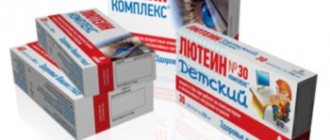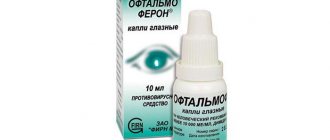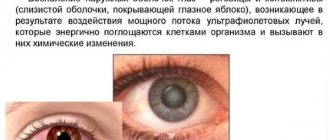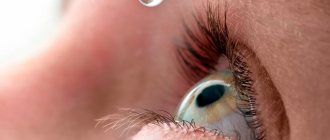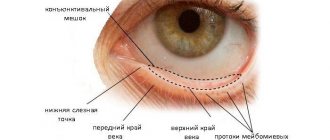Tsipromed instructions for use
Bacterial infections of the eyes and ears are easy to treat in the early stages. For inflammatory diseases, otolaryngologists (ENT) and ophthalmologists recommend the use of local antibiotics. Tsipromed belongs to the drugs in this group. It is active against many microorganisms that provoke the development of internal and external otitis, blepharitis, dacryocystitis and other inflammatory diseases of the eyelids, eyes and ears. In the postoperative period, the solution is used to prevent secondary infection.
Compound
The medicine is produced in two forms. Eye drops are a colorless or pale yellow liquid. They are packaged in opaque 5 ml bottles; the ciprofloxacin solution includes a pipette. Ear drops are a viscous, colorless or yellowish liquid. The main active ingredient in the drug is ciprofloxacin in the form of lactate. The solution is packaged in opaque dropper bottles of 10 ml. The full composition of the two release forms of Tsipromed is presented in the table below:
| Release form | Components | Concentration in mg |
| Ear drops | Ciprofloxacin lactate | 3 |
| Benzalkonium chloride, lactic acid, propylene glycol | — | |
| Eye drops | Ciprofloxacin hydrochloride | 3 |
| Lactic acid, sodium edetet, sodium hydroxide, sodium chloride, benzalkonium chloride, water for injection | — |
Pharmacodynamics and pharmacokinetics
The antibacterial effect of the drops is due to the presence of ciprofloxacin. This substance belongs to the group of fluoroquinolones and is considered an antibiotic. Ciprofloxacin inhibits bacterial DNA gyrase, which leads to disruption of the synthesis of daughter molecules of deoxyribonucleic acid and cell proteins. The drops are active against the following types of pathogenic microorganisms:
- Escherichia coli and hemophilus influenzae;
- salmonella, pseudomonas, brucella, chlamydia;
- Proteus mirabilis (indole-positive and indole-negative strains);
- Morgana bacterium, Gardnerella vaginalis, Moraxella catarrhalis;
- Citrobacter, Enterobacter, Acinetobacter;
- Klebsiella pneumonia;
- Yersinia, Vibrio, Campylobacter, Hafnia;
- Providence Stewart, Listeria monocytogenes;
- Pasteurella multicida, Legionella pneumophila;
- non-pathogenic Neisseria;
- staphylococci, streptococci;
- diphtheria corynebacterium.
Ear drops are practically not absorbed. The eye solution penetrates into all tissues, breast milk, and through them into the systemic bloodstream. In the anterior chamber of the eye, the maximum concentration of the antibiotic occurs 1 hour after instillation. The half-life of the drug from blood plasma is 5 hours. The drug is excreted from the body by the kidneys (50% - ciprofloxacin, 15% - metabolites of the active substance) and intestines (15%).
Indications for use
Ear drops are used to treat and prevent infectious diseases of the auditory system. They are prescribed for chronic, acute and infectious otitis of any form, before and after surgery, and for ear damage. The solution is used in the dosage specified in the instructions or prescribed by an ENT specialist. Tsipromed for eyes is used in the treatment of the following diseases:
- subacute and acute conjunctivitis;
- keratitis;
- blepharitis and other inflammatory diseases of the eyelids;
- prevention of inflammation after eye injury;
- subacute and acute dacryocystitis;
- anterior uveitis.
Indications for use
The injection solution and tablet form of Tsiprovet are prescribed after the following pathologies are detected:
- gastrointestinal diseases caused by pathogenic bacteria;
- infectious lesions of the liver and biliary system;
- diseases of the respiratory and genitourinary systems caused by bacterial microflora;
- inflammation and degenerative changes in cartilage and joints caused by infectious agents;
- purulent inflammation of the skin (abscesses, cellulitis, boils);
- infected wounds and postoperative sutures;
- secondary bacterial infections against the background of viral diseases, dermatitis, injuries, postoperative complications, etc.
In gynecological practice, this drug is used to treat metritis, endometritis, postpartum septicemia, and mastitis.
Important! During the period of antibacterial therapy, puppies are separated from the female and transferred to artificial feeding. This is a necessity, as it helps prevent infection of the offspring and speed up the recovery of the cat’s body.
Indications for the use of eye drops are:
- bacterial and chlamydial conjunctivitis;
- blepharitis;
- keratitis;
- inflammation of the eyelids, cornea or iris of a bacterial nature;
- ulcers formed on the cornea of the eye as a result of the activity of pathogenic microflora;
- damage to the organs of vision by mechanical, thermal or chemical agents.
Ophthalmic drops are prescribed before surgery in the eye area, as well as in the postoperative period to prevent infection of the wound surface.
Note! Before starting treatment, a very important factor is making an accurate diagnosis and determining the nature of the disease. This is explained by the fact that antibacterial therapy is powerless against pathologies caused by viruses and protozoa.
Eye drop solution
The solution for eye drops "Tsiprovet" looks like transparent
colorless and odorless liquid. The manufacturer packages the solution in plastic or glass bottles of 1, 5 and 10 ml. Original Tsiprovet drops are packaged one at a time in cardboard boxes.
Sediment, turbidity and impurities in the solution are a sign that the medicine is not suitable for use.
Indications
Tsiprovet drops are used to suppress harmful microflora in the eyes.
"Tsiprovet" is prescribed for cats if they are diagnosed with:
- acute, sluggish or purulent inflammation of the cornea of the eye, the mucous membrane of the eyelids;
- acute or chronic form of inflammation of the conjunctiva of the eye;
- mechanical damage to the eyes (injuries, punctures, etc.);
- ulcerative lesions of the surface of the cornea or the inside of the eyelids;
- inflammatory processes in the iris that are caused by bacteria.
Ciprovet drops are used for cats that are preparing for or have undergone eye surgery, as a prophylaxis against infectious inflammatory processes.
The drops cost about 135 rubles.
Contraindications
The Tsiprovet eye drop solution acts exclusively locally. It is not absorbed into the blood or lymph and its action is limited to the structures of the eye. Therefore, there are few restrictions on its use compared to tablets.
Ciprovet drops should not be used for cats with increased susceptibility to fluoroquinolone antibiotics (ciprofloxacin, ofloxacin, moxifloxacin).
If Ciprovet drops are prescribed for cats for the first time and they have not been given antibiotics of a similar composition before, it is necessary to check whether there is a reaction to the drug. To do this, the cat is given one drop of the solution and observed for 20 minutes. If after this time the redness does not increase and the cat is not worried, use
medicines are safe.
Do not use Tsiprovet drops for kittens that are less than a week old.
After using a full dose of the drug, the cat may feel a burning sensation - rub its eyes with its paw or rub its head against other objects. Unpleasant sensations and lacrimation usually go away on their own after 5-7 minutes.
If the cat continues to worry for a longer period of time, you should rinse the treated eye with warm, sterile saline and alert your veterinarian.
"Tsiprovet" should be used for cats with pathologies of the blood supply to the brain with caution and under the supervision of a veterinarian
Interaction with other drugs
The active ingredient "Tsiprovet" is not stable and is easily destroyed, so it is important not to mix it with other medications. Ciprofloxacin loses its effectiveness in an acidic environment, after contact with drugs that contain various metals
Usage diagram
Due to the instability of ciproflosacin, Ciprovet drops for cats are used no earlier than 5 minutes after using other medications.
Typically, “Tsiprovet” for cats is dripped into the affected eye 4-5 times a day, 1 drop at a time, trying to get under the eyelid. Afterwards, cover the treated eye with your hand so that the medicine is distributed evenly.
You can use other drops 5–7 minutes after Tsiprovet.
In acute cases, you can apply the medicine more often, up to 8 times a day.
If there is a lot of mucus or pus in the sore eye, before dropping Ciprovet, the eye is washed with warm saline solution and wiped to clean it as much as possible. After such preparation, 3 drops of medicine are dripped into the eye, blotted with a sterile napkin and another 1 drop is added.
How much to drip for cats and dogs
Ciprovet eye drops are prescribed:
- cats: 1 drop in each eye;
- dogs weighing from 2 to 10 kg, 1 drop;
- dogs weighing more than 10 kg – 2 drops.
Tsiprovet is dripped 4-6 times a day for 7-14 days.
The drug has limitations and contraindications and should only be prescribed by a veterinarian!
To prevent your pet from introducing additional infection into the sore eye, use a protective collar.
Directions for use and dosage
Drops are used exclusively for the treatment of local inflammation of the eyes or ears. It is prohibited to take them internally. According to the instructions, it is allowed to drip Tsipromed into the nose for a cold. The standard dosage is 2 drops in each nasal opening 2-3 times a day. For ear and eye infections, the dose of the drug depends on the type of disease and the patient's individual response to treatment.
Tsipromed ear drops
According to the instructions, before using the solution, it is necessary to sanitize the external ear canal and then dry it. Tsipromed is instilled into the ears 5 drops 3 times a day. After the symptoms of the disease disappear, therapy is continued for 48 hours. Before using Tsipromed ear drops, you should warm them to body temperature. After instilling the medicine, you need to keep your head thrown back for 2-3 minutes. To enhance the effect of the drug in the treatment of otitis, a cotton wool pad is placed in the external auditory canal. Drops can be used for ear injuries.
Tsipromed eye drops
This form of medication is used to treat lesions of the cornea, bacterial conjunctivitis, viral keratitis, and other infections of the eyeball and eyelids. The instructions for use say that 1-2 drops of the drug are instilled into the conjunctival sac of the affected eye. When treating ophthalmic infections, the following dosages of the drug are prescribed:
- For corneal damage caused by Pseudomonas aeruginosa, the drug is prescribed 1 drop 8-12 times a day. The duration of therapy is 14-20 days.
- During the treatment of blepharitis and acute bacterial conjunctivitis, the drug is instilled 1 drop 4-8 times a day. Duration of therapy is 2 weeks.
- To prevent secondary infection, prescribe 1 drop of the drug 4-8 times a day. Course – 2 weeks.
- For anterior uveitis, 1 drop of medication is prescribed 8-12 times a day. Therapy is continued until the condition of the choroid improves.
- After surgery, the product is instilled 1 drop up to 6 times a day throughout the entire postoperative period (does not exceed 1 month).
- To treat keratitis, instill 1 drop of solution 6-8 times a day. Therapy is continued until the cornea is completely healed.
- For acute dacryocystitis and canaliculitis, the antibiotic is instilled 1 drop 6-12 times a day. In the case of a chronic course of the disease - 4-8 times a day. The duration of therapy is determined by the doctor.
Dosage
Despite the fact that the manufacturer includes instructions for use with each package of the medicine, the medicine should be given to your pet based only on the treatment regimen drawn up by the veterinarian.
Typically, when using tablets to treat bacterial infections, the dose can be calculated based on the weight of the animal: 1 tablet per 3 kg of body weight. The medicine is given once a day, strictly at the same time for 3-5 days.
For eye diseases, treatment should be continued for 1-2 weeks, dripping 1-2 drops into each eye every 6 hours (4 times a day).
Ciprovet ciprofloxacin drops for cats
The drug is a colorless liquid, packaged in a plastic or glass bottle with a capacity of 5 mg or 10 mg, packed in a cardboard box. Plastic bottles have a special dispenser.
When packaged in glass bottles, you need to purchase a pipette for it. Includes:
- water for injection - up to 100%;
- ciprofloxacin hydrochloride—0.45%;
- benzalkonium chloride—0.05%;
- Trilon B—0.08%.
This drug is an antimicrobial and anti-inflammatory agent used in the fight against the following microorganisms:
- Pseudomonas aeruginosa;
- chlamydia;
- Staphylococcus aureus;
- icoplasma.
Drops are included without a pipette
Pharmacological effects of the drug
The active substance ciprofloxacin, after entering the digestive tract, is almost instantly absorbed by the walls of the stomach and intestines, distributed throughout all tissues and internal organs of the animal. The active substance can be absorbed through the placenta, into the ocular and lymphatic fluids, and blood.
Once at the site of inflammation, ciprofloxacin prevents the infection from spreading
An antibacterial substance, after entering the site of inflammation and infection, has an inhibitory effect on protein synthesis in bacterial cells, which causes the death of the harmful organism. By reducing the production of prostaglandins, the severity of the inflammatory process is reduced.
Impact speed
The required therapeutic concentration of the active substance after taking the prescribed dosage of the medication is noted within 24 hours. The maximum concentration of ciprofloxacin is achieved within 1-2 hours after taking the tablet. The liquid form of the drug quickly provides antibacterial and anti-inflammatory effects. The therapeutic concentration of the active substance is maintained for 12-24 hours.
Since “Tsiprovet” in the form of drops has a very gentle effect on the body, it can even be used on pregnant cats
Eye drops are used in the field of ophthalmology. Ciprofloxacin has its main effect in the eye chamber and cornea, with only small amounts entering the bloodstream and other tissues. Due to this, with gentle dosages it can be used during the animal’s pregnancy.
"Tsiprovet" quickly affects bacteria, inhibiting protein synthesis in their cells
More information about the drug Ciprovet for dogs
Tsiprovet is a veterinary drug produced by the domestic company Agrovetzashchita. Depending on the form of release, the medicine is used for small domestic animals, as well as in agricultural areas for birds, large and small livestock.
Action
Ciprovet is an antibacterial agent with a broad spectrum of action against most pathogenic microorganisms. When it enters the animal’s body, the active substance destroys the DNA of bacteria, as well as the integrity of the cell wall. As a result, their death occurs. The drug also eliminates special molecules that can subsequently cause resistance to this antibiotic.
Compound
Expert opinion
Kuzmenko Olga Olegovna
Information about the expert
Ask a Question
The main active ingredient, ciprofloxacin, belongs to the antibacterial agents of the fluoroquinolone group. When using tablets, it is absorbed in the small intestine and distributed throughout the body. After a day, the drug is excreted in urine, bile and milk (in lactating females).”
When applied topically (eye drops), the active substance easily penetrates the structures of the eye (cornea and anterior chamber).
Salts and water are used as excipients in eye drops, and lactulose, lactose, etc. in tablets.
Release form
Ciprovet is available in various forms:
- Solution for injections (intramuscular or subcutaneous).
- For oral administration - tablets, powder or solution (for birds and farm animals).
- Solution for topical use - eye drops.
Learn about essential antimicrobials in animals
- Trichopolum in veterinary medicine
- Instructions for the use of the antibiotic Baytril in animals
- Metronide in veterinary medicine. Instructions for use, doses, indications and contraindications
- Use of ceftriaxone for animals
- Explore the breadth of Metrogyl's antibacterial effect in animals
- Instructions for the use of doxycycline in animals. Study the breadth of doxycycline's antibacterial effects in animals. Calculate the optimal dose of the drug for different types. Improve therapy effectiveness by 140%
- Metronidazole (Metronidazole) for animals (instructions for use in veterinary medicine, doses, indications and contraindications)
- Atovaquone (ATOVAQUONE)
- Azithromycin for veterinary use
Pharmacokinetic properties
According to the instructions for use, CIPROVET eye drops, solution is quickly absorbed into the animal's eye after local ocular administration. Systemic levels are low after topical application. Plasma levels of ciprofloxacin in humans following 2 drops of a 0.45% ciprofloxacin solution every 2 hours for two days and then every four hours for 5 days ranged from not quantifiable (less than 1.0 ng/ml) to 4.7 ng / ml. The mean peak plasma levels of ciprofloxacin obtained in this study were approximately 450-fold lower than those obtained with a single 250 mg oral dose of ciprofloxacin. The systemic pharmacokinetic properties of ciprofloxacin have been well studied.
Ciprofloxacin is widely distributed throughout the tissues of the body.
The apparent volume of distribution at steady state is 1.7-5.0 l/kg. Binding to whey protein is 20-40%. The half-life of ciprofloxacin in serum is 3-5 hours. Both ciprofloxacin and its four main metabolites are excreted in urine and feces. Renal clearance accounts for approximately two-thirds of total serum clearance, with the remaining percentages being biliary and fecal tracts. In patients with impaired renal function, the half-life of Cyprovet is only moderately increased due to extrarenal elimination routes. Likewise, in patients with severely reduced liver function, the half-life is only slightly longer.
Composition and action
The active ingredient of the drug is ciprofloxacin hydrochloride. It is part of many antibacterial drugs that have proven themselves in medicine for treating people. But Tsiprovet contains a unique formula that allows the use of antibiotics in veterinary medicine without harm to the health of the pet.
The key features of the veterinary drug are:
- wide spectrum of action. Ciprofloxacin is effective against both gram-positive and gram-negative bacteria, including staphylococci, streptococci, Escherichia, salmonella, shigella, klebsiella and others;
- an innovative formula that includes prebiotics along with antibiotics helps maintain the balance of intestinal microflora;
- prolonged action - the medicine lasts 24 hours, which greatly facilitates use;
- rapid restoration of intestinal microflora.
The action of ciprofloxacin is to disrupt the protein synthesis of pathogenic microorganisms, which leads to their rapid death. The substance is quickly absorbed in the intestines and distributed throughout tissues and organs, also penetrating the lymph and placenta. The active substance reaches its maximum concentration in the blood serum within 1.5-2 hours, the therapeutic effect lasts for 24 hours.
Despite the presence of contraindications, the drug is safe, which, together with its high effectiveness, explains the popularity of Tsiprovet in veterinary medicine.
Storage conditions
All medical and veterinary drugs are effective in treatment only if the recommended storage conditions are observed. Tablets must be stored in hermetically sealed blisters and boxes from the manufacturer until direct use. The storage area should be dark, cool and dry.
Tsiprovet should be stored separately from animal feed and food, in a place inaccessible to animals and children. Storage temperature range from 0 to 25 degrees. If all storage conditions are met, the shelf life of the tablets is 4 years from the production date indicated on the packaging.
Drops are packaged in disposable, polyethylene or glass bottles with drip dispensers. The container should not be opened until immediate use. The bottles are packaged in cardboard boxes to protect them from exposure to sunlight.
Boxes with the drug should be stored in a dark and dry place. Relative humidity during storage should not exceed 60%. Drops should be stored separately from food and animal feed, out of the reach of children and animals. Storage temperature range from 5 to 25 degrees.
Tsiprovet is strictly not recommended for use after the expiration date. Drops should not be used if sediment or foreign matter appears in the liquid. Unused Tsiprovet is disposed of in the manner prescribed by law. Boxes and bottles from Tsiprovet cannot be used in everyday life.
Drugs with similar pharmacological properties
The substance ciprofloxacin, which forms the basis of the “Tsiprolet” product, is also contained in a number of other medications with similar pharmacological effects. So, let’s look further at what can replace this remedy. In terms of effectiveness, the following analogues are worth noting among the substitutes:
- The drug "Normax" is produced in India. It is used not only in ophthalmology, but also for the treatment of otitis media (inflammation of the hearing organs). It is unacceptable to treat patients with this drug before they reach the age of eighteen.
- The drug "Levomycetin" can be produced in various forms, including drops, pills and capsules. This is the closest medication to Tsiprolet, which is prescribed for the same indications.
- The drug "Albucid" belongs to the group of sulfonamides and is prescribed for ophthalmic pathologies of varying nature and severity.
- Medicine "Tobrex". It is based on an antibiotic called tobramycin. This drug can be used to treat eye diseases even in newborns.
- Sodium sulfacyl is a gentle antibacterial agent, which is also prescribed not only to adults, but also to young children.
- The drug "Oftaquix" is produced on the basis of levofloxacin, which is absorbed into the blood, so it is strictly contraindicated for nursing and pregnant women.
- Eye drops called “Floxal” are an effective antibacterial agent with a wide range of effects; they are used in the treatment of infections of the organs of vision for conjunctivitis, keratitis, and so on (for the so-called acute red eye).
- Eye ointment "Floxal" is used for diseases of the eyelids, for example, against the background of injuries and inflammations (including barley). This medication ensures the death of common infectious pathogens, such as chlamydia.
Contraindications
There are not so many of them in this dosage form of the drug. Or rather, there are only three: individual intolerance to the main active ingredient and other components, viral keratitis (this is logical, since antibiotics have no effect on viruses), as well as childhood from birth to one year. It is worth noting that tablets with the active ingredient “ciprofloxacin” are prohibited for use by children under the age of eighteen.
In addition to contraindications, the instructions also contain special instructions. While you are being treated with these drops, you should not wear soft contact lenses. Hard contact lenses should be removed and installed only after 15-20 minutes. If during the use of the drug there is no improvement or, on the contrary, it only gets worse, then you should not continue treatment according to the prescribed regimen. It is better to consult your doctor for additional recommendations. The doctor will conduct an examination and, if necessary, prescribe examinations and other treatment.
If, after instillation, unpleasant or painful sensations appear in the eyes that do not go away for a long time, then it is better to stop using the product and also consult an ophthalmologist. If more than 1 drug is prescribed, then it is better to dilute the time of instillation (the interval between administrations should be at least five minutes). The ready-made solution for instillation is not used as a solution for intraocular injections.
In case of accidental ingestion of the drug, it is recommended to consult a doctor. But negative consequences and overdose in such a situation are unlikely, since the maximum daily dose for an adult is 1 gram of ciprofloxacin, and for a child - 500 milligrams, while 1 bottle contains only 15 milligrams of the substance.
For pregnant and breastfeeding women, these eye drops are prescribed only in situations where the benefit to the woman is greater than the potential danger to the fetus or infant.
Contraindications of the solution
Tsiprovet drops are used for cats mainly for local effects. That is, the substance does not penetrate the body, the blood or lymph, but acts only at the level of the eye structure. Therefore, unlike tablets, the drug has virtually no restrictions on use.
Ciprovet drops are not suitable for cats that are hypersensitive to fluoroquinol antibiotics . It is also possible that an allergic reaction to one of the components of the drug may occur. Drops are not suitable for the treatment of eye diseases in newborn kittens under 1 week of age. The same rule applies to puppies.
© shutterstock
Immediately after using Tsiprovet, the cat's behavior may change. Usually, animals initially feel a burning sensation, so they begin to rub their injured eye with their paws or perform other actions that are unusual for them. Usually these unpleasant sensations, which also entail increased tearfulness, go away on their own after 6-7 minutes after instillation. If this does not happen, then you need to rinse the cat’s eye with saline and seek help from a veterinarian.
It is important not to use other external medications during the treatment process, since the active ingredient Ciprovet loses its properties and becomes ineffective.
You can also give your cat Tsiprolet in tablet form. In this case, the drug performs a wider range of functions, including eliminating infectious diseases of the digestive system, genitourinary system, inflammation of the liver, gall bladder, and lungs. But in this case, a veterinarian should prescribe treatment with Tsiprovet tablets, since taking antibiotics through carelessness or mistake can pose a threat to the animal’s life.
Side effects in veterinary medicine
Ciprovet may cause mild to serious side effects in animals. The following list contains some key side effects that may occur while taking Ciprovet. This list does not include all possible side effects:
- nausea
- diarrhea
- vomit
- stomach upset
- ataxia
- rash
In addition, liver test results may be higher than usual. This is usually temporary, but can also be a sign of liver damage.
Serious side effects and their symptoms may include:
- Tendon rupture or swelling
- Liver damage
- Severe allergic reaction
- Seizures, tremors, or epilepsy
- Intestinal infection
Learn about essential antimicrobials in animals
- Trichopolum in veterinary medicine
- Instructions for the use of the antibiotic Baytril in animals
- Metronide in veterinary medicine. Instructions for use, doses, indications and contraindications
- Use of ceftriaxone for animals
- Explore the breadth of Metrogyl's antibacterial effect in animals
- Instructions for doxycycline in animals
- Metronidazole (Metronidazole) for animals (instructions for use in veterinary medicine, doses, indications and contraindications)
- Atovaquone (ATOVAQUONE)
- Azithromycin for veterinary use
How does Ciprovet work?
Ciprofloxacin is an antibiotic of the fluoroquinolone class. This type of antibiotic is bactericidal. This means that it directly kills bacteria. It does this by blocking enzymes that are essential for the bacteria to survive.
Ciprovet is a broad-spectrum antibiotic.
This means that it works against many different types of bacteria. However, many bacteria may be resistant to Ciprovet.
Ciprovet eye drops are prescribed to animals for the following ophthalmological indications:
- for therapeutic purposes in acute and chronic conjunctivitis, keratoconjunctivitis, keratitis, corneal ulcers, septic iridocyclitis, blepharitis;
- for the purpose of preventing infectious eye diseases after injuries and foreign bodies, as well as in eye surgery during the preoperative and postoperative periods.
Release form and main properties of Tsiprovet
The solution, produced in the form of drops, is a clear liquid. It can be produced in glass or polyethylene containers of 5 and 10 ml. Its active substance is ciprofloxacin, which is an antibiotic.
© shutterstock
The action of Tsiprovet drops is to provide a bactericidal and anti-inflammatory effect. In fact, the spectrum of action of the drug is extensive. The substance is capable of fighting a variety of bacteria that multiply in the mucous membrane, including :
- mycoplasmas;
- chlamydia;
- Pseudomonas aeruginosa;
- strains;
- Staphylococcus aureus.
The solution blocks special enzymes of bacteria, thereby preventing their further reproduction.
Tsiprovet is prescribed to domestic cats by veterinarians for the treatment of various inflammations and eye diseases.:
- conjunctivitis;
- blepharitis;
- keratitis;
- corneal ulcers;
- other acute and chronic diseases.
An antibiotic is suitable for relieving inflammation of the eye appendages. The substance Tsiprovet is used to prevent infectious complications in the eyes, which can develop against the background of various injuries, after the unsuccessful entry of foreign bodies into the eye tissue. To prepare for eye surgery, animals are also prescribed Ciprovet drops.
© shutterstock
Ciprovet in animals
Ciprovet is sometimes prescribed by veterinarians to treat infections in animals. It is commonly used for the treatment of urinary tract infections, and may also be used for other types of infections.
If you think your dog or cat has an infection, contact your veterinarian for evaluation and treatment. Dosages are different for animals than for humans, so do not try to treat your pet with a Ciprovet prescription intended for humans.
If you think your pet has eaten Ciprovet, call your veterinarian immediately.
Contraindications and side effects
The medication belongs to the group of low-toxic drugs, so undesirable effects are recorded only when the recommended dosage is consistently exceeded or a negative reaction from the immune system develops. Undesirable effects resulting from the use of the drug include:
- Increased thirst.
- Swelling.
- Muscle spasm.
- The appearance of skin rashes.
- Decreased appetite, vomiting.
- Development of seizures.
- Loss of physical activity.
It is not recommended to use the drug for cats during pregnancy and lactation. The medication is not used to treat kittens under 7 months of age, emaciated or elderly animals suffering from chronic liver or kidney pathology. It is not recommended to use the drug if an animal has diseases of the nervous system that provoke convulsions or muscle spasms, or endocrine pathology.
The appearance of side effects can be caused by combined use with other pharmacological agents, therefore, when treating an animal, it is necessary to take into account that the medication:
- Incompatible with bacteriostatic antibiotics, which include tetracyclines, macrolides and Levomycetin.
- It becomes less effective when taken simultaneously with non-steroidal anti-inflammatory drugs, aluminum or magnesium preparations.
If undesirable effects occur, it is necessary to cancel treatment and contact a veterinarian to prescribe symptomatic therapy.
What kind of medicine is this
Tsiprovet is an antibacterial and anti-inflammatory drug.
Peculiarities
Due to its capabilities, the medicine has a complex effect on pathogens of various origins that can parasitize the eyes of a pet. It is known that the drug is active against Staphylococcus aureus, chlamydia, Pseudomonas aeruginosa, mycoplasmas, etc.
A significant advantage of this Tsiprovet is that it has the most durable therapeutic effect
This means that with its help it will be possible not only to get rid of some eye disease in a cat or dog, but also to minimize the risk of relapse, which is very important
| Characteristics of the drug | Release form | special instructions |
| Antibacterial agent with complex action. Price - around 130-150 rubles. Can be purchased at a veterinary pharmacy without a prescription. Ciprovet is used to destroy gram-positive and gram-negative bacteria and other single-celled microorganisms. | Currently, Ciprovet is available in the form of tablets and eye solution. The solution is a colorless, odorless liquid that is poured into glass or plastic bottles equipped with dispensers. Glass flasks do not have a dispenser, so you will have to work with a pipette. | Although a prescription is not required, you should always consult your doctor before using this product. It is quite possible that the eye disease in your pet is not caused by infections, therefore, the drug Ciprovet will be ineffective. |
Compound
The basis of the medicinal structure, both tablets and eye drops, is ciprofloxacin hydrochloride. It is an antibiotic from the fluoroquinolone family. It is clear that this substance is not found in Tsiprovet in its pure form. This is an aqueous solution, 0.45 percent.
All additional components do not have a medicinal purpose. They serve to increase the absorption of the drug, as well as to improve its conductivity. These substances include lactulose, calcium stearate, the same purified water, etc.
